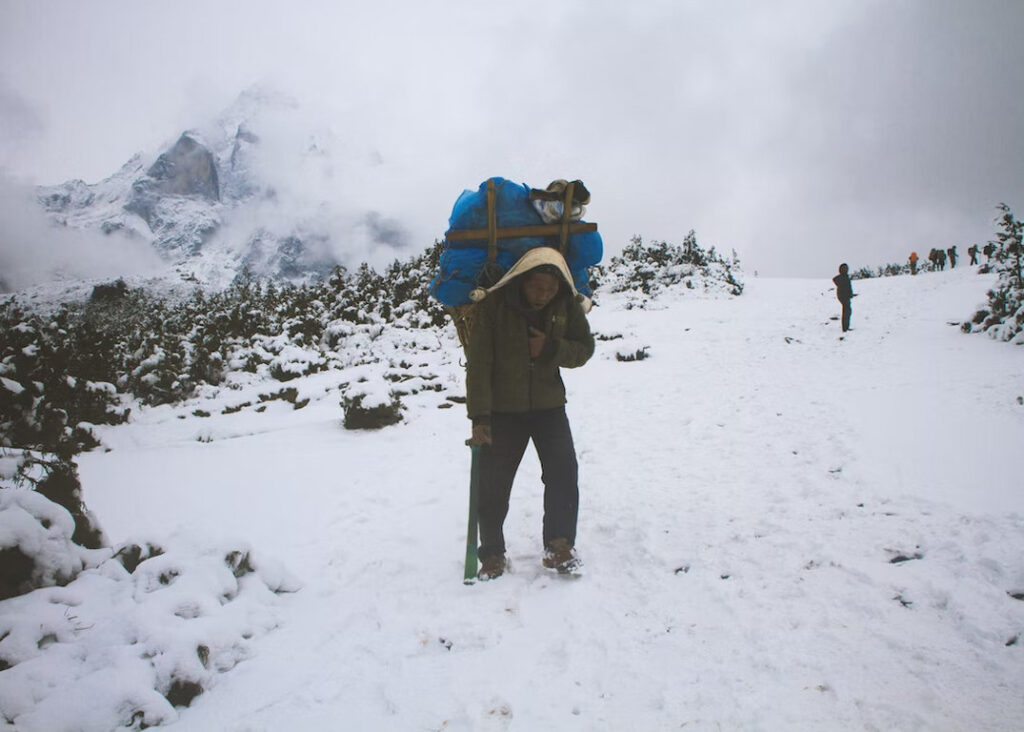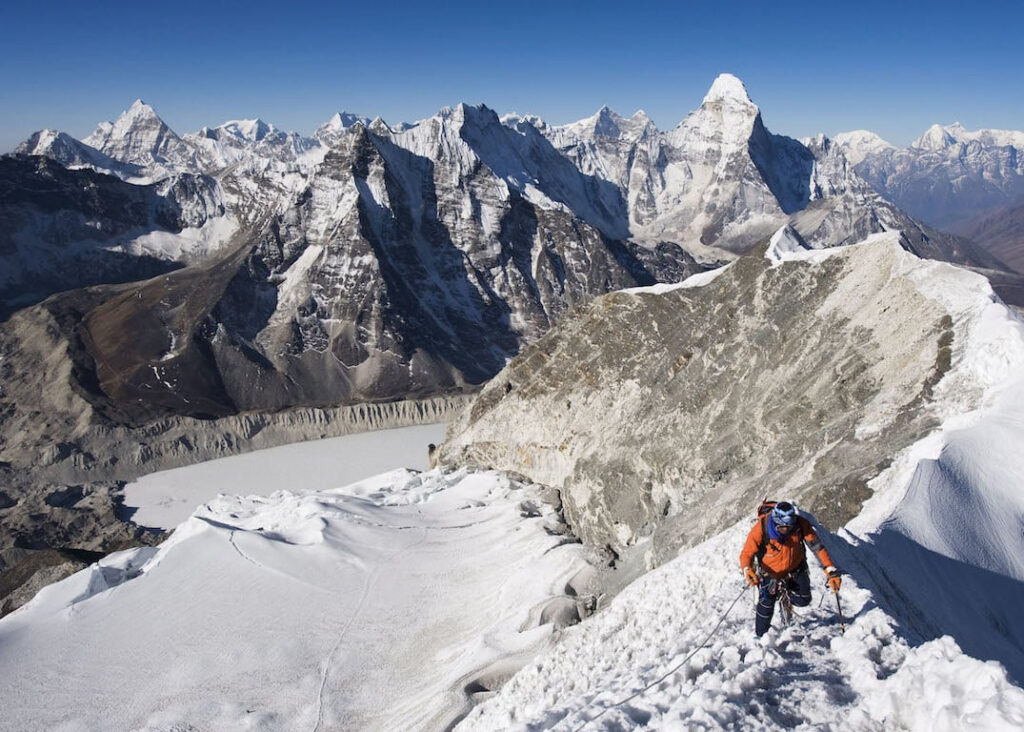Imja Tsho, a glacier lake in eastern Nepal’s Khumbu area, is one of the Himalayas’ fastest-growing lakes. Situated at an approximate elevation of 5,010 meters (16,440 feet), it is shaded by the enormous Imja Glacier and the lofty peaks of Lhotse and Everest.
When rising temperatures caused the Imja Glacier to retreat, the lake started to emerge in the 1960s. Imja Tsho Lake was formed when the glacier melted and the resulting meltwater collected behind a naturally occurring moraine dam.
The glacier melt has increased during the past few decades, causing the lake to rapidly expand in both area and volume. Imja Tsho now has an estimated water volume of 61.7 million cubic meters (2.2 billion cubic feet) and covers 1.3 square kilometers (0.5 square miles).
The possibility of a catastrophic glacial lake outburst flood (GLOF), which might severely endanger populations downstream, has caused grave worries due to this abrupt expansion.
History of Imja Tsho
Prior to the 1960s, Imja Tsho did not exist as a glacial lake. The area was occupied by the Imja Glacier, a valley glacier extending down from the southern slopes of Mount Everest and Lhotse in the Khumbu region of Nepal.
As global temperatures began rising in the latter half of the 20th century, the Imja and other glaciers in the Himalayas started experiencing accelerated melting and retreat. The retreating glacier left behind a small over-deepening, or depression, in the landscape.

Meltwater from the Imja Glacier started accumulating in this depression behind the glacier’s terminal moraine (ridge of debris). This collected water marked the beginnings of Imja Tsho around the early 1960s.
Over subsequent decades, the glacial melt increased dramatically due to climate change. This caused Imja Tsho to expand rapidly in both area and volume as more and more meltwater poured in.
By the late 1980s and early 1990s, the lake had grown to a size that raised concerns about the stability of the moraine dam containing it. Scientific studies identified Imja Tsho as one of the fastest-growing and most critically hazardous glacial lakes in the Himalayas.

Despite mitigation efforts like artificially lowering the lake level, Imja Tsho has continued its prolific expansion through the 2000s and 2010s as the Imja Glacier continues to lose mass from climate change.
Today, the lake contains over 61 million cubic meters of water held behind a moraine wall that experts warn could be structurally compromised, creating potential for catastrophic flooding downstream in the Dudh Koshi Valley if the dam fails.
Surroundings of Imja Tsho
Towering peaks of the Himalayas dominate the scenery around Imja Tsho, with Mount Everest and Lhotse looming the largest. The turquoise waters of the lake reflect the jagged ice formations and crevasses of the Imja Glacier that feed its growth. Rocky moraines and scree fields line the shorelines, formed by debris deposited by the retreating glacier.
Also Read: Phewa Lake: Nepal’s Second Largest Freshwater Lake
Barren slopes and cliffs surround the lake, devoid of vegetation due to the extremely high altitude. Only a few tiny alpine plants cling to life near the water’s edge. Streams of glacial meltwater continually pour into Imja Tsho from the Imja and other smaller glaciers clinging to the mountainsides. The landscape appears otherworldly, dominated by ice, rock, and the brilliant hues of the expanding lake.
Culture and lifestyle
However, the region around Imja Tsho in Nepal’s Khumbu Valley is the homeland of the Sherpa people, an ethnic group renowned for their mountaineering skills and spiritual connections to the Himalayas.
– The Sherpa are an Indigenous people descended from migrants from eastern Tibet. Many follow Tibetan Buddhist traditions.
– Sherpa villages like Dingboche and Pangboche are found near Imja Tsho, with centuries-old monasteries and religious sites.
– Traditional Sherpa livelihoods revolved around yak herding, agriculture at lower elevations, and trade facilitated by their mountaineering expertise.

– In modern times, many Sherpas have transitioned to supporting the trekking/mountaineering tourism industry as guides and porters.
– The Sherpas have a deep spiritual reverence for the mountains, glaciers, and sacred landscapes around them, including beliefs about deities and spirits residing in the peaks.
– Their cultures and traditions are inextricably tied to the harsh but beautiful Himalayan environment that Imja Tsho is now a part of.
So while not directly related to the glacial lake itself, the growth of Imja Tsho is unfolding against the rich cultural backdrop of the Sherpa people who have called this high-altitude glacial world home for centuries.
Flora and Fauna Near Imja Tsho
There is limited flora and fauna directly around the Imja Tsho glacial lake itself due to the extremely high-altitude environment. However, here are some details we can infer about the plant and animal life in the broader surrounding region:
Flora
– At the lake’s elevation of around 5,000m, any vegetation would be sparse alpine tundra plants like mosses, lichens, sedges, and small hardy shrubs.
– Lower down the Khumbu Valley, one finds pine, fir, birch, and rhododendron forests transitioning into alpine meadows at higher elevations.
You may also like: Flora and Fauna of the Himalayas, Nepal
– Some high-altitude medicinal plants like Himalayan rhubarb may grow near the lake’s shorelines.
Fauna
– The lake itself likely has minimal animal life beyond some migratory high-altitude bird species that may stop over.
– Mammals like Himalayan tahr, musk deer, or blue sheep could potentially graze the areas around the lake seasonally.
– Snow leopards, while very rare, do have ranges in the broader mountains and glaciers near Imja Tsho.
– The streams and rivers fed by glacial melt may contain high-altitude fish species like trout.
– The Imja Glacier itself would be largely devoid of life apart from some microbial extremophiles.
the flora and fauna in the vicinity of Imja Tsho is limited by the harsh climate and rugged glacial terrain. More life is found at lower elevations, with just patches of vegetation and migratory wildlife able to exist near the high-altitude glacial lake itself. As the lake expands with climate change, it may further impact fragile local ecosystems.
The best time to visit Imja Tsho
The prime season to visit Imja Tsho is during the spring and autumn months. From late April through May, temperatures become milder and skies are generally clear after the winter snows have melted. Autumn brings another window from late September through October before the harsh winter conditions set in.

During these shoulder seasons, trekkers can experience the stunning turquoise hues of the lake under bluebird Himalayan skies. The midday temperatures remain cool but tolerable for hiking around the high-altitude lake. Visiting in spring may allow visitors to catch glimpses of early wildflowers blooming in the lower reaches of the Khumbu Valley on the approach. By autumn, the landscapes take on a golden tinge as the brief window of fall colors passes through.
Things to do
Trekking – Imja Tsho lies along the popular Everest Base Camp trekking route in the Khumbu region. Trekkers can take multi-day hikes to reach viewpoints of the lake amid the stunning Himalayan scenery.
Glacier Hiking – With experienced guides and proper equipment, it may be possible to carefully explore and hike on the lower portions of the Imja Glacier that feeds the lake.
Photography – The brilliant turquoise waters set against the backdrop of Everest, Lhotse, and the ice formations make for incredible photography opportunities when the skies are clear.
Nature Observation – Keep an eye out for Himalayan wildlife like tahr, musk deer or high-altitude bird species that may be spotted around the lake’s rocky moraines.
More: Lakes of Nepal: Begnas Lake, the Third Largest Lake in Nepal
Cultural Tours – While trekking to Imja Tsho, visitors can explore ancient Sherpa Buddhist monasteries and villages like Pangboche to experience the local culture.
Scientific Study – Imja Tsho is a focus for glaciological research into glacial lake outburst flooding risks. Visitors may see researchers monitoring and studying the lake.
Overall, most activities revolve around taking in the breathtaking high-altitude scenery and evidence of glacial retreat that Imja Tsho represents, combined with cultural immersion experiences with the local Sherpa people. Proper acclimatization and trekking support is a must for visiting this remote Himalayan locale.







